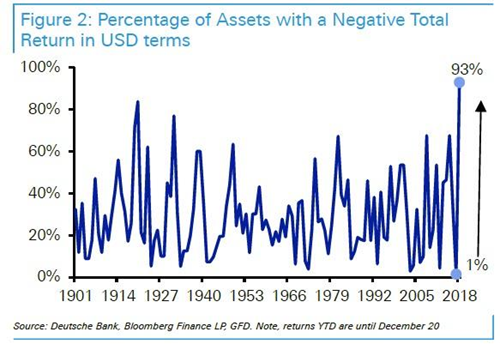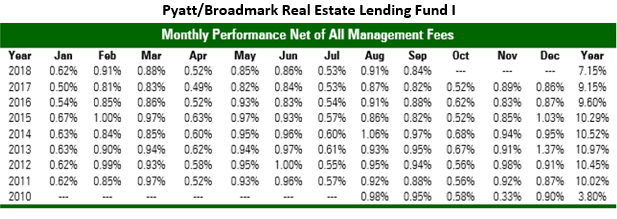FORECASTS & TRENDS E-LETTER
by Gary D. Halbert
December 31, 2018
IN THIS ISSUE:
- A Record 93% of Asset Classes Are Down in 2018
- Several of Our Alternative Investments Have Performed Much Better
- Broadmark Real Estate Lending Funds Revisited
- Conclusions: Diversify With Non-Correlated Investments
Q3 hedge fund letters, conference, scoops etc
Overview
It goes without saying that 2018 did not turn out as we all hoped just a few months ago, before the stock markets peaked and then plunged sharply lower. So much for the usual “Santa Claus rally” and another record-breaking year in the equity markets.
What we have witnessed since September is one of the most volatile market meltdowns on record. And it’s not limited to the US and global stock markets. As we end the year, 2018 will be the worst year on record, with 93% of asset classes down for the year – even worse than during the Great Depression and the Great Recession of 2008-2009. And it all happened so quickly!
Unfortunately, this correction in stocks may not be over yet, but I have good news to think about as we ring in the New Year.
Most of you know that we at Halbert Wealth Management have worked very hard over the past few years to find successful, professionally-managed “alternative investments” that have low-to-no correlation with the stock and bond markets. Several of the alternative strategies I have recommended herein over the last several years do not involve stocks or bonds at all.
In light of the recent market meltdown, I suspect many of you are rethinking your portfolio allocations, and the alternative investments we recommend can help with that.
So, my New Year’s Resolution is to convince more of you to add these successful, non-correlated investments to your portfolios, if suitable for your financial goals and risk tolerance.
These investments include a very successful stock options strategy, a highly successful longevity fund (life insurance) and several consistently profitable commercial real estate funds (REITs), which have nothing to do with the stock and bond markets. Most of these strategies have been profitable this year, despite the carnage in the stock markets.
A Record 93% of Asset Classes Are Down in 2018
Two months ago in early November, Deutsche Bank reported that as of the end of October, 89% of assets that the German bank collects data on had a negative total return year-to-date in dollar terms. This was the highest percentage on record based on data back to 1901, eclipsing the previous high of 84% hit in 1920.
Commenting on this striking observation of a market in which almost nothing worked, Deutsche Bank said: “This is what happens when the vast majority of global assets are expensive historically due to extreme [Fed] monetary policy. When the tide goes out you’re more likely to get en masse negative months…”
The bank added that the Fed moving from peak Quantitative Easing (QE) to Quantitative Tightening (QT): “has been enough to reverse a significant amount of the liquidity-inspired asset price returns of the pre-tightening era.”
But most importantly, Deutsche Bank concluded that the chart in question showing the percentage of global assets that were down on a dollar adjusted basis each year since 1901 was “the most requested chart we’ve ever been involved in”, and as updated below, “2018 continues to the be the worst year on record on this measure with 93% of assets currently down – worse than the years of the Great Depression.”
The record bearish reading is made all the more fascinating, considering that just one year ago, 2017, was the “best year” ever for markets on this measure, when just 1% of asset classes finished with a negative total return in dollar terms. Wow, the best year and the worst year back-to-back!
Putting these two extreme years in context, since 1901 the average has been that 29% of assets finish a given year with a negative total return, leading Deutsche to exclaim that it’s been “an amazing couple of years nonetheless as we swing from one extreme to the other.”
Several of Our Alternative Investments Have Performed Much Better
I don’t question Deutsche Bank’s finding that 93% of asset classes have performed negatively in 2018. What I do want to point out is the fact that several of the alternative investments we recommend at Halbert Wealth Management have performed positively this year.
For example, in the last two years, I have introduced you to four real estate investment trusts (REITs) with impressive track records and low-to-no correlation to stocks – all of which were profitable as of the end of November. We’ll have final results for the year next month.
And we have other professionally-managed, non-correlated alternative investments that are profitable so far in 2018.
The point is, these alternative-to-stocks investments have done well over time and have continued to deliver profits in 2018, even as stocks have been hammered in the last several months. As always, of course, I have to add the caveats that these investment programs involve risk and are not suitable for all investors, and past performance is not necessarily indicative of future results.
Broadmark Real Estate Lending Funds Revisited
Of all the REITs I have recommended this year, I have written the most about the Broadmark Real Estate Lending Funds, largely because of their consistency of returns and low drawdowns (losing periods). The Broadmark Funds make short-term construction loans to builders of homes, condominiums, apartments and other commercial real estate.
The loans are secured by the underlying real estate in the form of senior first deed of trust mortgages. That way, if the builder gets into trouble, the Funds can foreclose on the borrower, finish the construction and sell the completed project. The Broadmark Funds write hundreds of first position, senior secured loans to builders to diversify and reduce risk.
Importantly, Broadmark uses a maximum 65% Loan-to-Value ratio when making these loans. This means if the completed project securing the note is valued at $1,000,000, they would only loan up to 65% or $650,000 to the borrower. If the borrower defaults on the $650,000 loan in this example, the Fund would then take possession of the property, finish construction and sell the completed project.
In addition, no leverage is used by Broadmark. In other words, they do not use any borrowed funds to increase the amount of money they can loan. Some funds gather money from investors and then borrow additional funds to increase the amount of loans they make.
While the use of leverage can help enhance returns, it also greatly increases the risks, especially in the event of a default or downturn in the real estate market. Broadmark does not use leverage, so as to lower the risks in their Funds.
The best thing about the Broadmark Funds is the consistency of returns and low drawdowns. As you can see, the Pyatt/Broadmark Real Estate Lending Fund I has delivered consistent performance and low volatility since the Fund started in 2010.
These are actual returns, net of all fees and expenses. While past performance is no guarantee of future results, you can see they have thus far been able to deliver consistent returns to their investors.
An added bonus of the Broadmark Funds is that since they are loans made on real estate, their performance is not highly correlated to the markets. Since the inception of their Funds, they have had low correlation to both stocks and bonds. That’s a big plus, especially with what’s happened to the stock markets recently.
Both of the Broadmark Funds are audited annually by Cohn Reznick, New York, NY. You must be an “accredited investor” to invest in these Funds. The minimum investment is $100,000 and there is a one-year lock-up. After that, redemptions are permitted at the end of each quarter.
If you’re looking for an investment strategy with a history of delivering consistent and attractive returns with low volatility, you should seriously consider Pyatt/Broadmark Real Estate Lending Fund I and Broadmark Real Estate Lending Fund II for your portfolio.
If you are not an accredited investor, we have some other options with real estate exposure that you should consider. We also have actively-managed non-real estate strategies you should learn more about for diversifying your portfolio.
If you are an accredited investor, but you haven’t let us know that, register with us today. That way, we can send you information on all of the investments we offer. Remember, your financial information is completely secure with us.
[Important Notes: Halbert Wealth Management is registered with the SEC and the respective states. Information provided is from sources believed to be reliable, but its accuracy cannot be guaranteed. Any opinions stated are intended as general observations, not specific or personal investment advice. Please review the offering materials before making a decision to invest.
Past performance is no guarantee of future performance. All programs involve risk and there is no guarantee there will not be any losses. These Funds are only available to accredited investors.]
Conclusions: Diversify With Non-Correlated Investments
Given the debacle we’ve seen in the markets over the last several months, there has never been a better reason to consider alternative investments that have low-or-no correlation to the stock and bond markets. As discussed above, we have a stable of non-correlated, professionally managed alternative strategies with proven track records.
At the end of the day, the question is, why haven’t you joined us and diversified your portfolio to include some or all of these strategies that made money in 2018 when 93% of asset classes had losses?
Given that almost all asset classes lost money, yet several of our alternative investments made money this year, you should contact us right away for more information.
Finally, in my discussions with readers who are not clients over the years, the most common response is: Well, I reside in XYZ (state of your choice), and you are in Texas; I prefer to invest with someone local.
The problem is, there’s probably not a boutique investment firm like Halbert Wealth Management near you. Second, there is very little chance that your local financial advisors know about or have access to the non-correlated alternative strategies we offer.
Think about it this way: Fidelity Investments is headquartered in Boston. Do you live near there? Probably not. Vanguard Investments is headquartered in Pennsylvania. Do you live there? Again, probably not.
In this Internet day and age, it should not matter if you are located near your financial advisor, especially if that advisor can provide you with successful non-correlated investment opportunities. We have clients in almost every state, and I have never met most of them in person.
The bottom line is that we work very hard at Halbert Wealth Management to find money managers with: 1) successful performance records; and 2) strategies that are not highly correlated with the performance of stocks and bonds. For the record, we do offer some traditional investment programs as well.
So, my parting advice to you as we close out 2018 is to become a client of Halbert Wealth Management and take advantage of the alternative investments I recommend. You can start small if you wish, but if our past record is any indication, you will steadily increase your investment with us over time.
Finally, whatever you decide to do, I appreciate your readership. If not for that, this publication would not exist.
HAPPY NEW YEAR,
Gary D. Halbert


